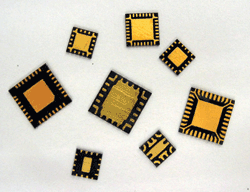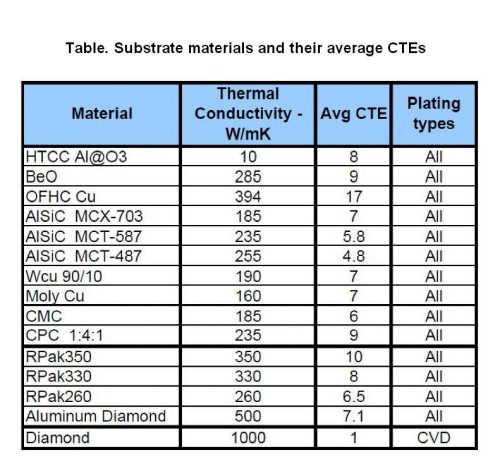IC packaging advances yield smaller, high-rel sensors
As device performance requirements climb, thermal management plays an increasingly important role in package selection
BY DAVE DEWIRE
RJR Polymers, Oakland, CA
www.rjrpolymers.com
The worldwide sensor market is growing by leaps and bounds. Indicative of that trend, analysts following large mainstream industries such as automotive manufacturers are now predicting that cars five years from now will integrate up to ten times the sensors they use today as they collect ever more data to manage and optimize performance. Not surprisingly, the designers in these industries are facing a familiar problem; how do they squeeze a rapidly escalating number of sensors into limited board space while preserving high reliability and low cost? A new generation of cost-effective, highly compact QFN packages based on innovative Liquid Crystal Polymer (LCP) technology offers a promising alternative to traditional sensor packaging solutions (fig. 1 ).

Fig. 1. New QFN packages offer all the advantages of low cost, near-hermetic LCP technology in highly compact footprints capable of supporting finer lead pitches and thinner lead frames.
Packaging challenges
Over the past few decades overmolded and ceramic packaging solutions have served the needs of sensor applications well. Both technologies bring inherent benefits and offer designers clear-cut tradeoffs between cost, performance and reliability. But IC designers have had to cope with each technology’s widely recognized limitations as well.
Lower-cost overmolded solutions, for instance, are constructed by filling a mold with thermosetting epoxy which encapsulates a preassembled lead frame. This process completely embeds the die and wire bonds with the polymeric material. As a result these packages exhibit higher parasitics than air cavity packages limiting both output power and gain. Moreover, these packages are vulnerable to reliability problemsbecause they demonstrate a relatively high moisture-absorption rate. Since the mold compound must adhere to the die, wire bonds and lead material, overmolded solutions are often subject to the “popcorn” effect, when trapped moisture explodes during the assembly process.
While air cavity ceramic packages offer excellent durability in high-temperature reflow processes, they also present distinct liabilities. The assembly process required to form the air cavity is an expensive one. In addition, the parts assembly process requires that parts be plated to a near common gold thickness, which has become an increasingly expensive operation as the price of gold has sharply risen.
Most importantly, as device performance requirements continue to climb, thermal management has played an increasingly important role in package selection. Since ceramic packages require coefficient of thermal expansion (CTE) matching to avoid cracking of the ceramic, they are limited in the use of very high thermal conductivity materials and/or flanges such as copper. This restriction, in turn, severely limits design flexibility.
LCP advances
Recent advances in liquid-crystal-polymer (LCP) packaging technology promise major improvements in sensor reliability at a competitive cost. Based on a strong inert thermoplastic that is both non-flammable and resistant to corrosion and solvents, this new technology uses a standard thermoplastic injection-molding process that combines a sidewall and optional lid with a wide variety of interchangeable base materials. Each base material can be selected to meet specific product design requirements while offering multiple degrees of thermal performance for different applications.
Packaging manufacturers using this technology create an air cavity package by combining a patented sealing technology with injection molding of a low moisture diffusivity LCP. The technology uses the same basic assembly process as an overmolded package.
The primary difference lies in how the packages are sealed. With an LCP package, the air cavity is sealed with a cover after component assembly into the premolded cavity in the package. These packages use a modified LCP compound for the dielectric molded around the metal lead frames.
Design flexibility
The design flexibility of this technology offers numerous advantages in the sensor market. For example, Mirion Technologies, a manufacturer of radiation sensors for nuclear and medical environments, has used LCP packaging for a new clip-on radiation sensor that can indicate exposure in real time.
Unlike traditional radiation sensors that require the user to send a badge back to the manufacturer for analysis, this new device features an integrated USB port that links to a computer and immediately indicates the length and location of the exposure, the type of radiation, and its quantity. Key to that achievement was the use of packaging technology that combines both conductive and non-conductive LCP and multiple passive devices into a single integrated package (see Fig. 1 ).
Arguably the most dangerous threat to long term sensor reliability is moisture. In rapidly growing sensor markets such as MEMS, hermetic packaging is often required. For these types of applications, the LCP approach offers a distinct advantage.
With a very low water absorption rate of just 0.02%, this packaging technology supplies near-hermetic reliability eliminating the need in many applications for additional packaging steps to meet this requirement. As part of the assembly process, the leads are coated with a moisture resistant polymer and sealed at injection molding. Moreover, the technology is flexible enough to be built to either custom requirements or most industry standard configurations, including quad flat packs (QFPs), quad flat no-leads (QFNs), and small-outline (SO) solutions. Since the manufacturing process incorporates thermoplastic molding techniques, additional product features such as ports and connectors can be designed into the package or lid.
In fact, recent advances in LCP QFN design promise to help designers pack more sensors into smaller board footprints. For instance, the latest generation of QFN LCP packages offer support for finer lead pitches and shorter wire bond lengths. These new MSL III-compliant packages now support lead frames as thin as 0.008 in. Moreover, they are able to withstand multiple non-lead reflows while remaining leak tight. In early testing, the new QFN packages passed over 500 thermal cycles from –65°C to 150°C with no gross leak failures.
Finally, LCP technology’s modular approach and the ability to cost-effectively swap out any of a variety of thermally-enhanced bases to tailor the technology’s CTE offer unmatched design flexibility. With base options that run from ceramic (LTCC/HTCC) to copper or diamond, designers can easily build solutions that offer thermal conductivity capabilities that range from 10 to 100 W/mK.
By selecting a copper flange, for example, a designer can achieve as much as a 25% reduction in thermal resistance over comparable ceramic solutions, dramatically improving energy efficiency and lowering power consumption. Yet the assembly process remains highly cost-effective.
Packages are molded around a lead frame in a multi-up format. The LCP is then formulated to match the CTE of the lead frame to minimize stress and maximize reliability (see table ). Accordingly, designers can tool a specific size package, using just one injection mold, and simply change out the lead frames to create a diverse family of products.

Clearly, rapid growth in the sensor market will drive increasing demand for packaging technologies that can deliver new levels of reliability and performance while using highly cost effective, automated assembly processes. By using a highly flexible, modular design that delivers near-hermetic reliability in an air cavity package using a low cost, standardized molding process, recent advances in LCP packaging give manufacturers an exciting opportunity to redefine the cost/performance equation in sensor design. ■
Advertisement
Learn more about RJR Polymers





